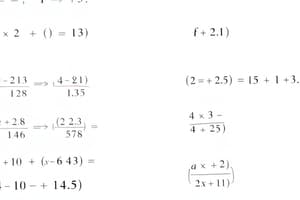Podcast
Questions and Answers
What is the factored form of the expression $x^2 - 9$?
What is the factored form of the expression $x^2 - 9$?
- $(x - 3)(x + 3)$ (correct)
- $(x - 4)(x + 4)$
- $(x + 3)^2$
- $(x - 9)(x + 9)$
Which method would be most appropriate to solve the system of equations: $2x + 3y = 6$ and $4x - 3y = 12$?
Which method would be most appropriate to solve the system of equations: $2x + 3y = 6$ and $4x - 3y = 12$?
- Graphing
- Substitution
- Factoring
- Elimination (correct)
Which expression can be factored as a perfect square trinomial?
Which expression can be factored as a perfect square trinomial?
- $x^2 - 6x + 9$ (correct)
- $x^2 - 5x + 4$
- $x^2 + 5x + 6$
- $x^2 + 2x - 8$
In the slope-intercept form $y = mx + b$, what does the 'm' represent?
In the slope-intercept form $y = mx + b$, what does the 'm' represent?
Which of the following is not a characteristic of parallel lines?
Which of the following is not a characteristic of parallel lines?
What is the GCF of the terms in the expression $15x^2 + 5x$?
What is the GCF of the terms in the expression $15x^2 + 5x$?
According to the sum of cubes formula, what is the factored form of $x^3 + 8$?
According to the sum of cubes formula, what is the factored form of $x^3 + 8$?
What is the y-intercept of the linear equation expressed as $2x + 4y = 8$?
What is the y-intercept of the linear equation expressed as $2x + 4y = 8$?
Study Notes
Algebra Study Notes
Factoring
- Definition: The process of breaking down an expression into simpler components (factors) that multiply together to give the original expression.
- Common Methods:
- Factoring out the Greatest Common Factor (GCF): Identify the largest factor common to all terms.
- Difference of Squares: ( a^2 - b^2 = (a - b)(a + b) ).
- Quadratic Trinomials: For ( ax^2 + bx + c ), look for two numbers that multiply to ( ac ) and add to ( b ).
- Perfect Square Trinomials: ( a^2 + 2ab + b^2 = (a + b)^2 ) and ( a^2 - 2ab + b^2 = (a - b)^2 ).
- Sum/Difference of Cubes:
- ( a^3 + b^3 = (a + b)(a^2 - ab + b^2) )
- ( a^3 - b^3 = (a - b)(a^2 + ab + b^2) ).
Linear Equations
- Definition: An equation that makes a straight line when graphed, generally in the form ( ax + b = c ).
- Standard Form: ( Ax + By = C ) where ( A, B, C ) are constants and ( A ) and ( B ) are not both zero.
- Slope-Intercept Form: ( y = mx + b ) where:
- ( m ) = slope
- ( b ) = y-intercept
- Solving Methods:
- Graphing: Plotting the equation to find the intersection point.
- Substitution: Solving one equation for a variable and substituting into another.
- Elimination: Adding or subtracting equations to eliminate a variable.
- Key Concepts:
- Slope: The rate of change represented as rise/run.
- Intercepts: Points where the line crosses the axes (x-intercept and y-intercept).
- Parallel Lines: Have the same slope but different y-intercepts.
- Perpendicular Lines: Slopes are negative reciprocals of each other.
Factoring
- Factoring is essential to simplify expressions into their constituent parts that multiply to recreate the original expression.
- Greatest Common Factor (GCF): To factor, first determine the largest factor that all terms share, then factor it out.
- Difference of Squares: The formula ( a^2 - b^2 = (a - b)(a + b) ) allows to rewrite expressions as products of binomials.
- Quadratic Trinomials: For expressions of the form ( ax^2 + bx + c ), identify two numbers that multiply to ( ac ) and sum to ( b ) for effective factoring.
- Perfect Square Trinomials: Recognize forms such as ( a^2 + 2ab + b^2 = (a + b)^2 ) or ( a^2 - 2ab + b^2 = (a - b)^2 ) for efficient factoring.
- Sum and Difference of Cubes: Utilize the identities ( a^3 + b^3 = (a + b)(a^2 - ab + b^2) ) and ( a^3 - b^3 = (a - b)(a^2 + ab + b^2) ) to transform cubic expressions.
Linear Equations
- Linear equations yield straight lines when graphed and are typically represented as ( ax + b = c ).
- Standard Form: Express linear equations as ( Ax + By = C ) with non-zero constants ( A ) and ( B ).
- Slope-Intercept Form: The format ( y = mx + b ) reveals the slope ( m ) and y-intercept ( b ), essential for graphing.
- Solution Methods:
- Graphing: Visually find the intersection of equations, useful for determining solutions in a two-dimensional space.
- Substitution: Resolve one variable in terms of another and substitute back into the system for a solution.
- Elimination: Combine equations to eliminate one variable, simplifying the system to find the remaining variable.
- Key Concepts:
- Slope indicates the steepness of the line, calculated as the rise over run.
- Intercepts describe where the line intersects the axes, specifically x-intercepts and y-intercepts.
- Parallel Lines share identical slopes but differ in y-intercepts, indicating they will never meet.
- Perpendicular Lines have slopes that are negative reciprocals, showcasing a specific angle of intersection.
Studying That Suits You
Use AI to generate personalized quizzes and flashcards to suit your learning preferences.
Description
Explore the fundamentals of factoring and linear equations with this algebra quiz. Test your understanding of common factoring techniques and the characteristics of linear equations. Perfect for students looking to reinforce their algebra skills.




